Response of Vegetation and Soil Property Changes by Photovoltaic Established Stations Based on a Comprehensive Meta-Analysis
Abstract
:1. Introduction
2. Materials and Methods
2.1. Co-Occurrence Network of Keywords
2.2. Data Collection and Processing
2.3. Statistical Analysis
3. Results
3.1. Geographical Distribution of Studies
3.2. Effects of Photovoltaic Power Stations on Different Factors
4. Discussion
5. Conclusions
- The responses to soil and vegetation to the construction of PV power stations exhibit significant differences between studies, which are related to the different environmental contexts across ecosystems. Desert, cropland, and grassland ecosystems demonstrated significant positive, genitive, and insignificant effects, respectively.
- The construction of PV panels generally increases SWC, vegetation diversity, coverage, and biomass. Among these, biomass experienced the most substantial growth.
- Although the construction of PV power stations does not significantly affect soil physicochemical properties, it suppresses soil respiration and evaporation and significantly enhances vegetation productivity and coverage in the Northern Hemisphere.
Supplementary Materials
Author Contributions
Funding
Data Availability Statement
Conflicts of Interest
References
- Tsoutsos, T.; Frantzeskaki, N.; Gekas, V. Environmental impacts from the solar energy technologies. Energy Policy 2005, 33, 289–296. [Google Scholar] [CrossRef]
- Turney, D.; Fthenakis, V. Environmental impacts from the installation and operation of large-scale solar power plants. Renew. Sustain. Energy Rev. 2011, 15, 3261–3270. [Google Scholar] [CrossRef]
- Semeraro, T.; Pomes, A.; Del Giudice, C.; Negro, D.; Aretano, R. Planning ground based utility scale solar energy as green infrastructure to enhance ecosystem services. Energy Policy 2018, 117, 218–227. [Google Scholar] [CrossRef]
- Bai, Z.; Jia, A.; Bai, Z.; Qu, S.; Zhang, M.; Kong, L.; Sun, R.; Wang, M. Photovoltaic panels have altered grassland plant biodiversity and soil microbial diversity. Front. Microbiol. 2022, 13, 1065899. [Google Scholar] [CrossRef]
- Hernandez, R.R.; Easter, S.; Murphy-Mariscal, M.L.; Maestre, F.T.; Tavassoli, M.; Allen, E.B.; Barrows, C.W.; Belnap, J.; Ochoa-Hueso, R.; Ravi, S. Environmental impacts of utility-scale solar energy. Renew. Sustain. Energy Rev. 2014, 29, 766–779. [Google Scholar] [CrossRef]
- Hernandez, R.R.; Hoffacker, M.K.; Field, C.B. Efficient use of land to meet sustainable energy needs. Nat. Clim. Change 2015, 5, 353–358. [Google Scholar] [CrossRef]
- Trainor, A.M.; McDonald, R.I.; Fargione, J. Energy Sprawl Is the Largest Driver of Land Use Change in United States. PLoS ONE 2016, 11, e0162269. [Google Scholar] [CrossRef] [PubMed]
- Stoms, D.M.; Dashiell, S.L.; Davis, F.W. Siting solar energy development to minimize biological impacts. Renew. Energy 2013, 57, 289–298. [Google Scholar] [CrossRef]
- Zhang, Y.; Tian, Z.; Liu, B.; Chen, S.; Wu, J. Effects of photovoltaic power station construction on terrestrial ecosystems: A meta-analysis. Front. Ecol. Evol. 2023, 11, 1151182. [Google Scholar] [CrossRef]
- Barron-Gafford, G.A.; Minor, R.L.; Allen, N.A.; Cronin, A.D.; Brooks, A.E.; Pavao-Zuckerman, M.A. The Photovoltaic Heat Island Effect: Larger solar power plants increase local temperatures. Sci. Rep. 2016, 6, 35070. [Google Scholar] [CrossRef]
- Devitt, D.A.; Apodaca, L.; Bird, B.; Dawyot, J.P.; Fenstermaker, L.; Petrie, M.D. Assessing the Impact of a Utility Scale Solar Photovoltaic Facility on a Down Gradient Mojave Desert Ecosystem. Land 2022, 11, 1315. [Google Scholar] [CrossRef]
- Wall, D.H. Soil Ecology and Ecosystem Services; Oxford University Press: Oxford, UK, 2012. [Google Scholar]
- Lambert, Q.; Bischoff, A.; Cueff, S.; Cluchier, A.; Gros, R. Effects of solar park construction and solar panels on soil quality, microclimate, CO2 effluxes, and vegetation under a Mediterranean climate. Land Degrad. Dev. 2021, 32, 5190–5202. [Google Scholar] [CrossRef]
- Wu, Z.; Hou, A.; Chang, C.; Huang, X.; Shi, D.; Wang, Z. Environmental impacts of large-scale CSP plants in northwestern China. Environ. Sci. Process. Impacts 2014, 16, 2432–2441. [Google Scholar] [CrossRef] [PubMed]
- Lambert, Q.; Bischoff, A.; Enea, M.; Gros, R. Photovoltaic power stations: An opportunity to promote European semi-natural grasslands? Front. Environ. Sci. 2023, 11, 1137845. [Google Scholar] [CrossRef]
- Zhang, Z.; Shang, W.; Wang, Q.; Fu, G.; Zhang, W.; Wan, X. Biodiversity of Herbaceous Species under Large Photovoltaic (PV) Power Stations in Desert Region of Hexi Corridor. J. Northwest For. Univ. 2020, 35, 190–196, 212. [Google Scholar]
- Li, P.; Gao, X. The impact of photovoltaic power plants on ecological environment and climate: A literature review. J. Plateau Meteorol 2021, 40, 702–710. [Google Scholar]
- Hernandez, R.R.; Armstrong, A.; Burney, J.; Ryan, G.; Moore-O’Leary, K.; Diédhiou, I.; Grodsky, S.M.; Saul-Gershenz, L.; Davis, R.; Macknick, J.; et al. Techno-ecological synergies of solar energy for global sustainability. Nat. Sustain. 2019, 2, 560–568. [Google Scholar] [CrossRef]
- Armstrong, A.; Ostle, N.J.; Whitaker, J. Solar park microclimate and vegetation management effects on grassland carbon cycling. Environ. Res. Lett. 2016, 11, 074016. [Google Scholar] [CrossRef]
- Heimann, M.; Reichstein, M. Terrestrial ecosystem carbon dynamics and climate feedbacks. Nature 2008, 451, 289–292. [Google Scholar] [CrossRef]
- Chock, R.Y.; Clucas, B.; Peterson, E.K.; Blackwell, B.F.; Blumstein, D.T.; Church, K.; Fernández-Juricic, E.; Francescoli, G.; Greggor, A.L.; Kemp, P. Evaluating potential effects of solar power facilities on wildlife from an animal behavior perspective. Conserv. Sci. Pract. 2021, 3, e319. [Google Scholar] [CrossRef]
- Gurevitch, J. A meta-analysis of field experiments on competition. Am. Nat. 1992, 140, 539–572. [Google Scholar] [CrossRef]
- Arnqvist, G.; Wooster, D. Meta-analysis: Synthesizing research findings in ecology and evolution. Trends Ecol. Evol. 1995, 10, 236–240. [Google Scholar] [CrossRef] [PubMed]
- Curtis, P. A meta-analysis of leaf gas exchange and nitrogen in trees grown under elevated carbon dioxide. Plant Cell Environ. 1996, 19, 127–137. [Google Scholar] [CrossRef]
- Gurevitch, J.; Curtis, P.S.; Jones, M.H. Meta-Analysis in Ecology; Elsevier: Amsterdam, The Netherlands, 2001. [Google Scholar]
- Feng, Y.; Schmid, B.; Loreau, M.; Forrester, D.I.; Fei, S.; Zhu, J.; Tang, Z.; Zhu, J.; Hong, P.; Ji, C. Multispecies forest plantations outyield monocultures across a broad range of conditions. Science 2022, 376, 865–868. [Google Scholar] [CrossRef] [PubMed]
- Hua, F.; Bruijnzeel, L.A.; Meli, P.; Martin, P.A.; Zhang, J.; Nakagawa, S.; Miao, X.; Wang, W.; McEvoy, C.; Peña-Arancibia, J.L. The biodiversity and ecosystem service contributions and trade-offs of forest restoration approaches. Science 2022, 376, 839–844. [Google Scholar] [CrossRef] [PubMed]
- Xu, C.; Silliman, B.R.; Chen, J.; Li, X.; Thomsen, M.S.; Zhang, Q.; Lee, J.; Lefcheck, J.S.; Daleo, P.; Hughes, B.B. Herbivory limits success of vegetation restoration globally. Science 2023, 382, 589–594. [Google Scholar] [CrossRef]
- Lundgren, E.J.; Bergman, J.; Trepel, J.; le Roux, E.; Monsarrat, S.; Kristensen, J.A.; Pedersen, R.Ø.; Pereyra, P.; Tietje, M.; Svenning, J.-C. Functional traits—Not nativeness—Shape the effects of large mammalian herbivores on plant communities. Science 2024, 383, 531–537. [Google Scholar] [CrossRef] [PubMed]
- Al Mamun, M.A.; Dargusch, P.; Wadley, D.; Zulkarnain, N.A.; Aziz, A.A. A review of research on agrivoltaic systems. Renew. Sustain. Energy Rev. 2022, 161, 112351. [Google Scholar] [CrossRef]
- Burda, B.U.; O’Connor, E.A.; Webber, E.M.; Redmond, N.; Perdue, L.A. Estimating data from figures with a Web-based program: Considerations for a systematic review. Res. Synth. Methods 2017, 8, 258–262. [Google Scholar] [CrossRef]
- Wang, Z.; Huang, H.; Wang, H.; Peñuelas, J.; Sardans, J.; Niinemets, Ü.; Niklas, K.J.; Li, Y.; Xie, J.; Wright, I.J. Leaf water content contributes to global leaf trait relationships. Nat. Commun. 2022, 13, 5525. [Google Scholar] [CrossRef]
- Han, H.; Li, C.; Liu, R.; Jian, J.; Abulimiti, M.; Yuan, P. Warming promotes accumulation of microbial- and plant-derived carbon in terrestrial ecosystems. Sci. Total Environ. 2023, 905. [Google Scholar] [CrossRef] [PubMed]
- Gu, W.; Jiapaer, G.; Yin, H.; Jiang, L.; Zang, X. Spatial and temporal distribution characteristic and division research of solar energy resources in southern Xinjiang. Arid. Land Geogr. 2021, 44, 1665–1675. [Google Scholar]
- Yang, G.; Gui, Q.; Liu, J.; Chen, X.; Cheng, S. Spatial-temporal evolution and driving factors of ecological security in China based on DPSIR-DEA model: A case study of the Three Gorges reservoir area. Ecol. Indic. 2023, 154, 110777. [Google Scholar] [CrossRef]
- Yuan, Y.; Bai, Z.; Zhang, J.; Huang, Y. Investigating the trade-offs between the supply and demand for ecosystem services for regional spatial management. J. Environ. Manag. 2023, 325, 116591. [Google Scholar] [CrossRef] [PubMed]
- Zhang, D.; Wang, X.; Qu, L.; Li, S.; Lin, Y.; Yao, R.; Zhou, X.; Li, J. Land use/cover predictions incorporating ecological security for the Yangtze River Delta region, China. Ecol. Indic. 2020, 119, 106841. [Google Scholar] [CrossRef]
- Hedges, L.V.; Gurevitch, J.; Curtis, P.S. The meta-analysis of response ratios in experimental ecology. Ecology 1999, 80, 1150–1156. [Google Scholar] [CrossRef]
- Liu, C.; Lu, M.; Cui, J.; Li, B.; Fang, C. Effects of straw carbon input on carbon dynamics in agricultural soils: A meta-analysis. Glob. Change Biol. 2014, 20, 1366–1381. [Google Scholar] [CrossRef]
- Viechtbauer, W. Conducting meta-analyses in R with the metafor package. J. Stat. Softw. 2010, 36, 1–48. [Google Scholar] [CrossRef]
- Bracken, M. Statistical methods for analysis of effects of treatment in overviews of randomized trials. In Effective Care of the Newborn Infant; Oxford University Press: Oxford, UK, 1992; pp. 13–20. [Google Scholar]
- Chen, J.; van Groenigen, K.J.; Hungate, B.A.; Terrer, C.; van Groenigen, J.-W.; Maestre, F.T.; Ying, S.C.; Luo, Y.; Jorgensen, U.; Sinsabaugh, R.L.; et al. Long-term nitrogen loading alleviates phosphorus limitation in terrestrial ecosystems. Glob. Change Biol. 2020, 26, 5077–5086. [Google Scholar] [CrossRef]
- Tian, P.; Liu, S.; Zhao, X.; Sun, Z.; Yao, X.; Niu, S.; Crowther, T.W.; Wang, Q. Past climate conditions predict the influence of nitrogen enrichment on the temperature sensitivity of soil respiration. Commun. Earth Environ. 2021, 2, 251. [Google Scholar] [CrossRef]
- Lefcheck, J.S. piecewiseSEM: Piecewise structural equation modelling in r for ecology, evolution, and systematics. Methods Ecol. Evol. 2016, 7, 573–579. [Google Scholar] [CrossRef]
- Whittaker, R.H. Communities and Ecosystems; Macmillan Company: London, UK, 1975. [Google Scholar]
- Jiang, B.; Zhang, B.; Li, L.; Zhao, Y.; Shi, Y.; Jiang, Q.; Jia, L. Analysis of microbial community structure and diversity in surrounding rock soil of different waste dump sites in fushun western opencast mine. Chemosphere 2021, 269, 128777. [Google Scholar] [CrossRef] [PubMed]
- Li, Y.; Zhou, W.; Jing, M.; Wang, S.; Huang, Y.; Geng, B.; Cao, Y. Changes in Reconstructed Soil Physicochemical Properties in an Opencast Mine Dump in the Loess Plateau Area of China. Int. J. Environ. Res. Public Health 2022, 19, 706. [Google Scholar] [CrossRef] [PubMed]
- Liu, D.; Huang, Y.; An, S.; Sun, H.; Bhople, P.; Chen, Z. Soil physicochemical and microbial characteristics of contrasting land-use types along soil depth gradients. Catena 2018, 162, 345–353. [Google Scholar] [CrossRef]
- Chang, Z.; Liu, S.; Zhu, S.; Han, F.; Zhong, S.; Duan, X. Ecological Functions of PV Power Plants in the Desert and Gobi. J. Resour. Ecol. 2016, 7, 130–136. [Google Scholar]
- Li, S.; Gao, Q.; Wang, X.; Lan, L.; Yang, Z. Characteristics of Vegetation and Soil Property Changes by Photovoltaic Plant Interference in Alpine Desert Steppe. J. Soil Water Conserv. 2016, 30, 325–329. [Google Scholar]
- Wu, C.; Liu, H.; Yu, Y.; Zhao, W.; Liu, J.; Yu, H.; Yetemen, O. Ecohydrological effects of photovoltaic solar farms on soil microclimates and moisture regimes in arid Northwest China: A modeling study. Sci. Total Environ. 2022, 802, 149946. [Google Scholar] [CrossRef] [PubMed]
- Basche, A.D.; Kaspar, T.C.; Archontoulis, S.V.; Jaynes, D.B.; Sauer, T.J.; Parkin, T.B.; Miguez, F.E. Soil water improvements with the long-term use of a winter rye cover crop. Agric. Water Manag. 2016, 172, 40–50. [Google Scholar] [CrossRef]
- Wang, F.; Wang, Y.; Lyu, H.; Fan, Z.; Hu, F.; He, W.; Yin, W.; Zhao, C.; Chai, Q.; Yu, A. No-tillage mulch with leguminous green manure retention reduces soil evaporation and increases yield and water productivity of maize. Agric. Water Manag. 2023, 290, 108573. [Google Scholar] [CrossRef]
- Hu, A.; Levis, S.; Meehl, G.A.; Han, W.; Washington, W.M.; Oleson, K.W.; Van Ruijven, B.J.; He, M.; Strand, W.G. Impact of solar panels on global climate. Nat. Clim. Change 2016, 6, 290–294. [Google Scholar] [CrossRef]
- Li, Z.; Sun, X.; Zhou, J.; Wu, L.; Bi, D.; Zhao, J.; Zhu, R.; Christie, P. Sustainable phytoextraction of metal-polluted agricultural land used for commercial photovoltaic power generation. J. Clean. Prod. 2023, 391, 136093. [Google Scholar] [CrossRef]
- Amaducci, S.; Yin, X.; Colauzzi, M. Agrivoltaic systems to optimise land use for electric energy production. Appl. Energy 2018, 220, 545–561. [Google Scholar] [CrossRef]
- Armstrong, A.; Waldron, S.; Whitaker, J.; Ostle, N.J. Wind farm and solar park effects on plant-soil carbon cycling: Uncertain impacts of changes in ground-level microclimate. Glob. Change Biol. 2014, 20, 1699–1706. [Google Scholar] [CrossRef] [PubMed]
- Valle, B.; Simonneau, T.; Sourd, F.; Pechier, P.; Hamard, P.; Frisson, T.; Ryckewaert, M.; Christophe, A. Increasing the total productivity of a land by combining mobile photovoltaic panels and food crops. Appl. Energy 2017, 206, 1495–1507. [Google Scholar] [CrossRef]
- Weselek, A.; Ehmann, A.; Zikeli, S.; Lewandowski, I.; Schindele, S.; Hoegy, P. Agrophotovoltaic systems: Applications, challenges, and opportunities: A review. Agron. Sustain. Dev. 2019, 39, 35. [Google Scholar] [CrossRef]
- Zhou, M.; Wang, X. Influence of photovoltaic power station engineering on soil and vegetation: Taking the Gobi Desert Area in the Hexi corridor of Gansu as an example. Sci. Soil Water Conserv. 2019, 17, 132–138. [Google Scholar]
- Jin, J.; Cai, Y.; Guo, X.; Wang, L.; Wang, Y.; Liu, Y. Decoupled driving forces of variabilities of transpiration in Chinese subtropical vegetation based on remote sensing data. J. Geogr. Sci. 2023, 33, 2159–2174. [Google Scholar] [CrossRef]
- Yue, D.; Zhou, Y.; Guo, J.; Chao, Z.; Guo, X. Relationship between net primary productivity and soil water content in the Shule River Basin. Catena 2022, 208, 105770. [Google Scholar] [CrossRef]
- MacKay, D.J. Solar energy in the context of energy use, energy transportation and energy storage. Philos. Trans. R. Soc. A Math. Phys. Eng. Sci. 2013, 371, 20110431. [Google Scholar] [CrossRef]
- Elamri, Y.; Cheviron, B.; Lopez, J.M.; Dejean, C.; Belaud, G. Water budget and crop modelling for agrivoltaic systems: Application to irrigated lettuces. Agric. Water Manag. 2018, 208, 440–453. [Google Scholar] [CrossRef]
- Liu, Y.; Zhang, R.-Q.; Huang, Z.; Cheng, Z.; Lopez-Vicente, M.; Ma, X.-R.; Wu, G.-L. Solar photovoltaic panels significantly promote vegetation recovery by modifying the soil surface microhabitats in an arid sandy ecosystem. Land Degrad. Dev. 2019, 30, 2177–2186. [Google Scholar] [CrossRef]
- Tian, Z.-Q.; Zhang, Y.; Liu, X.; Chen, S.-Y.; Liu, B.-L.; Wu, J.-H. Effects of Photovoltaic Power Station Construction on Terrestrial Environment: Retrospect and Prospect. Huan Jing Ke Xue = Huanjing Kexue 2024, 45, 239–247. [Google Scholar]
- Zhang, N.; Duan, H.; Shan, Y.; Miller, T.R.; Yang, J.; Bai, X. Booming solar energy is encroaching on cropland. Nat. Geosci. 2023, 16, 932–934. [Google Scholar] [CrossRef]
- Stern, R.; Muller, J.D.; Rotenberg, E.; Amer, M.; Segev, L.; Yakir, D. Photovoltaic fields largely outperform afforestation efficiency in global climate change mitigation strategies. PNAS Nexus 2023, 2, pgad352. [Google Scholar] [CrossRef] [PubMed]
- Li, Z.B.; Zhang, Y.; Wang, M. Solar energy projects put food security at risk. Science 2023, 381, 740–741. [Google Scholar] [CrossRef] [PubMed]
- McClung, M.R.; Moran, M.D. Minimizing Impacts of Future Renewable Energy Development on the World’s Desert Ecosystems. Front. Sustain. 2022, 3, 900468. [Google Scholar] [CrossRef]
- Hernandez, R.R.; Hoffacker, M.K.; Murphy-Mariscal, M.L.; Wu, G.C.; Allen, M.F. Solar energy development impacts on land cover change and protected areas. Proc. Natl. Acad. Sci. USA 2015, 112, 13579–13584. [Google Scholar] [CrossRef]
- Technical Guidelines for Environmental Impact Assessment—Ecological Impact; Ministry of Ecology and Environment of People’s Republic of China: Beijing, China, 2020; Volume HJ 19-2022, pp. 1–25.
- Needham, B. Dutch Land-Use Planning: The Principles and the Practice; Routledge: London, UK, 2016. [Google Scholar]
- Schützenberger, J. OÖ Photovoltaik-Strategie 2030: Eine Machbarkeitsstudie über die Errichtung einer PV-Freiflächenanlage auf einem rekultivierten Quarzsandtagebau; Westsächsische Hochschule Zwickau: Zwickau, Germany, 2023. [Google Scholar]
- Stamford, L.; Azapagic, A. Environmental impacts of photovoltaics: The effects of technological improvements and transfer of manufacturing from Europe to China. Energy Technol. 2018, 6, 1148–1160. [Google Scholar] [CrossRef]
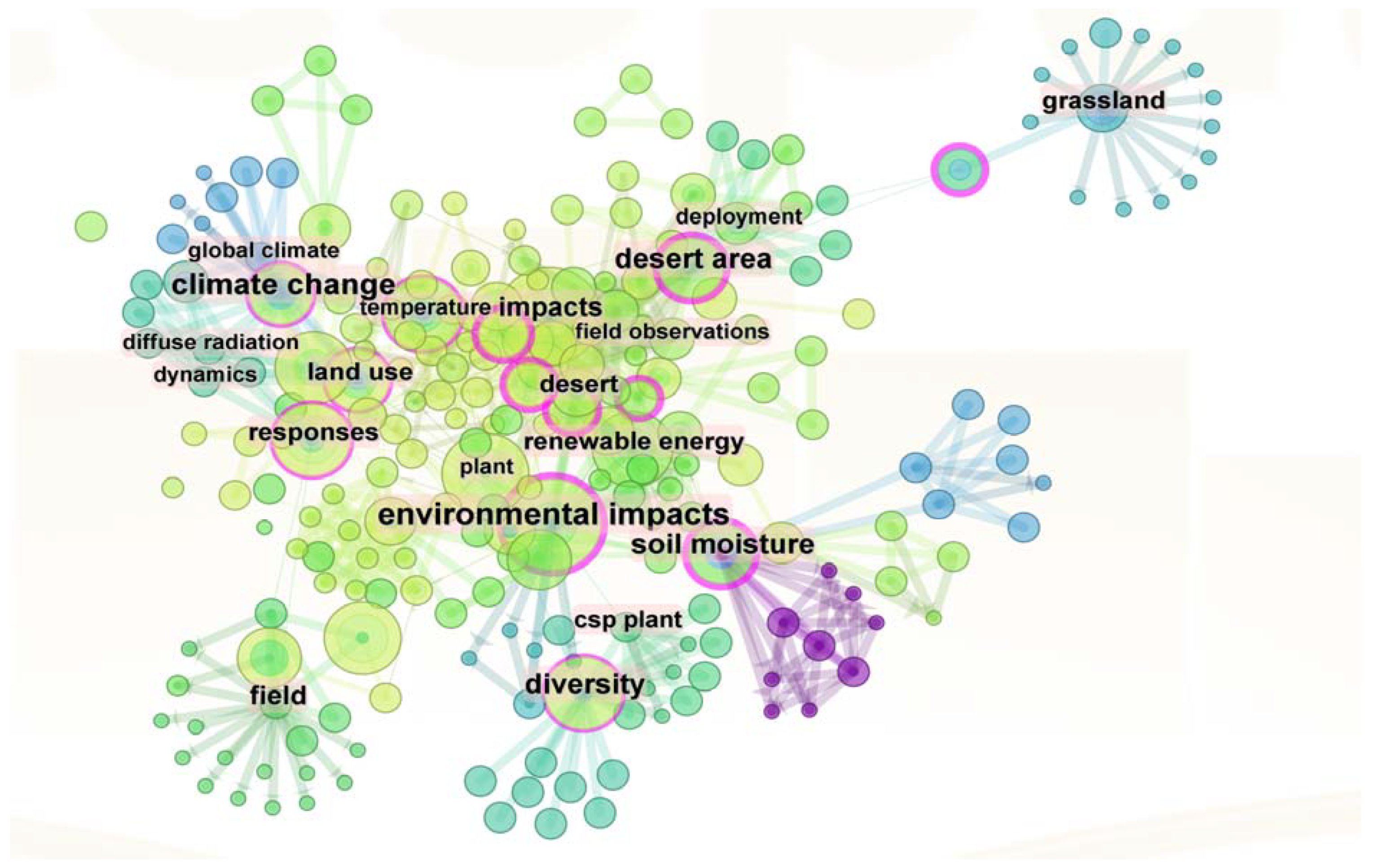

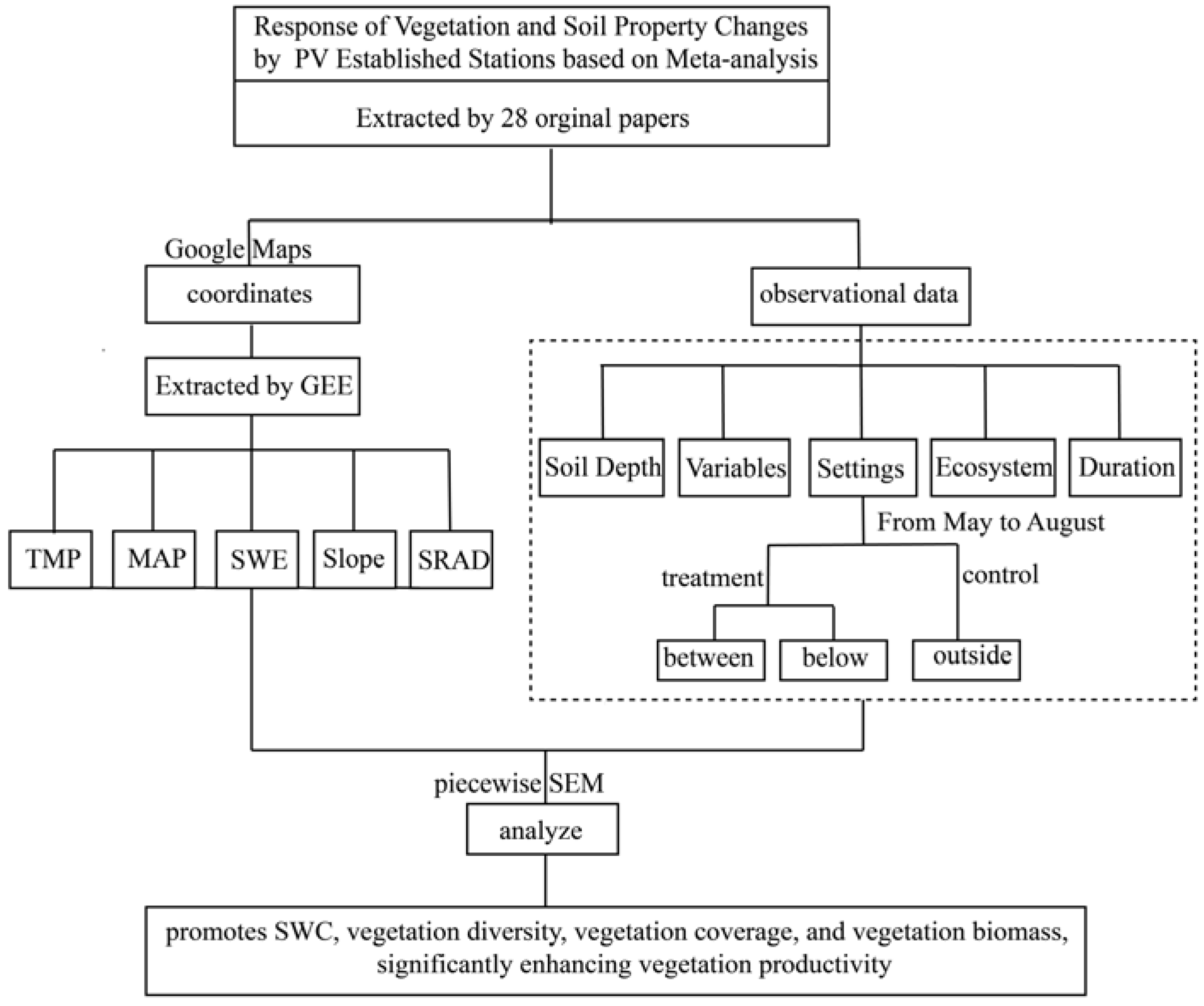
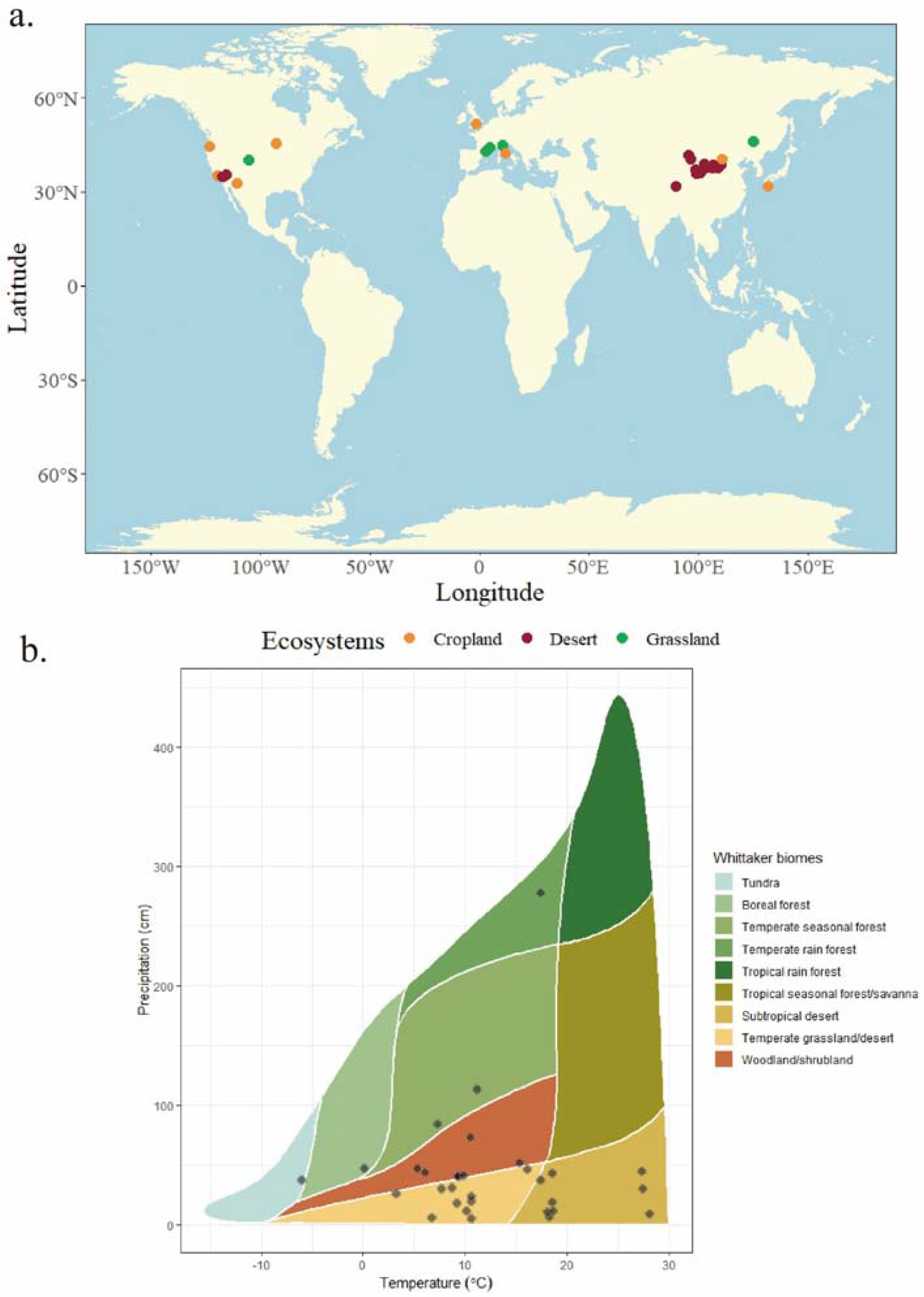






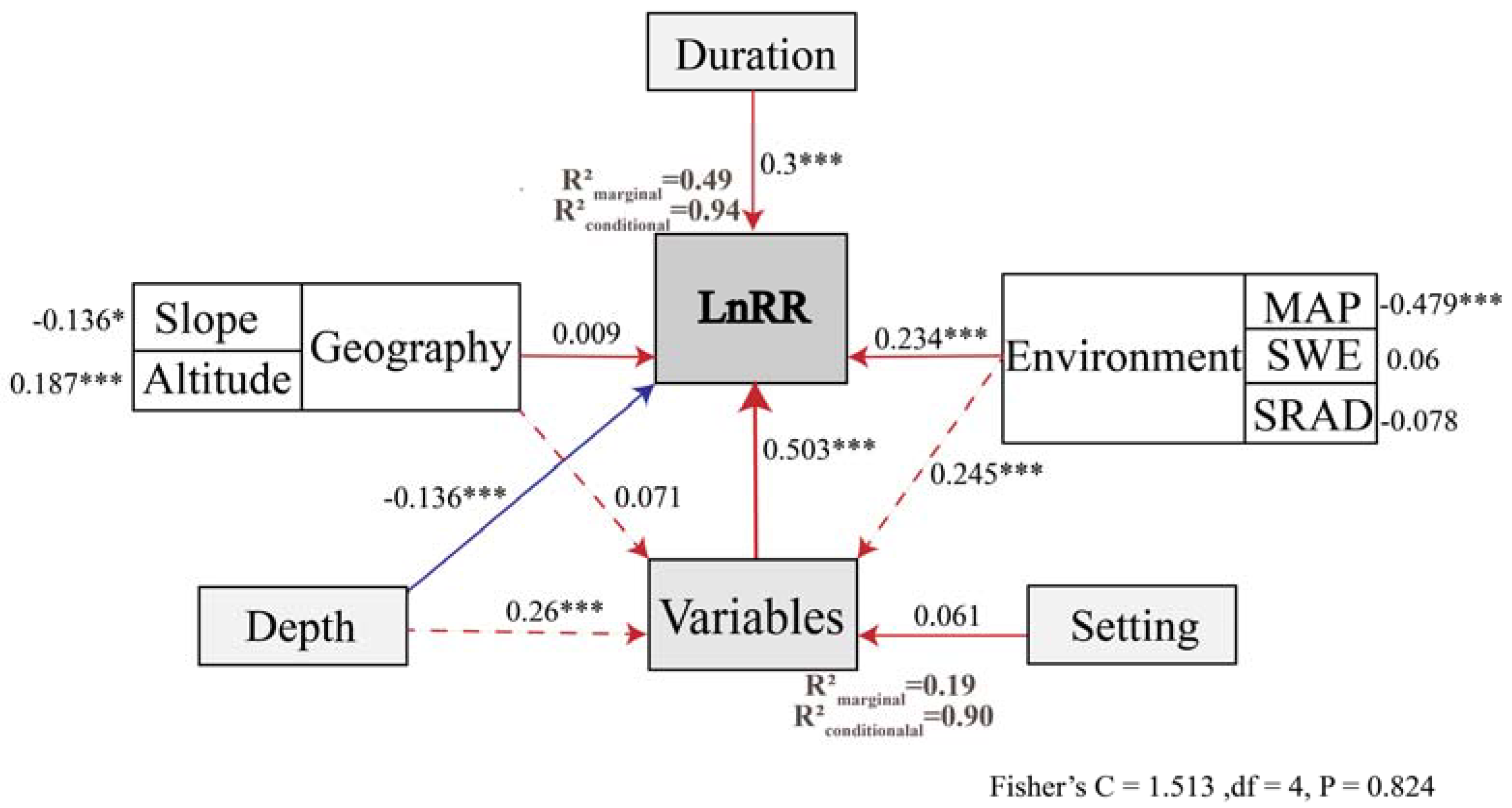
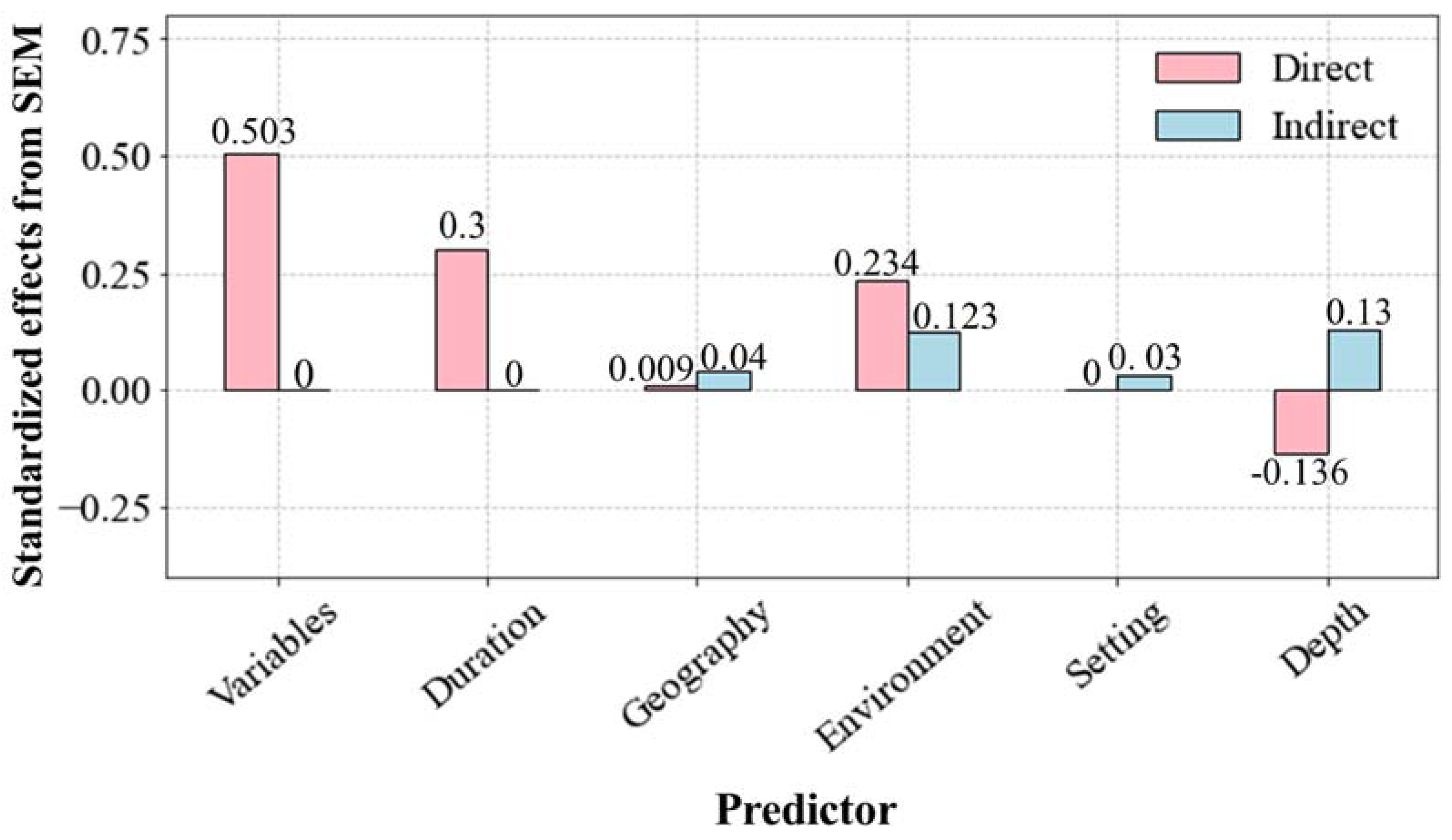
Disclaimer/Publisher’s Note: The statements, opinions and data contained in all publications are solely those of the individual author(s) and contributor(s) and not of MDPI and/or the editor(s). MDPI and/or the editor(s) disclaim responsibility for any injury to people or property resulting from any ideas, methods, instructions or products referred to in the content. |
© 2024 by the authors. Licensee MDPI, Basel, Switzerland. This article is an open access article distributed under the terms and conditions of the Creative Commons Attribution (CC BY) license (https://creativecommons.org/licenses/by/4.0/).
Share and Cite
Chen, X.; Chen, B.; Wang, Y.; Zhou, N.; Zhou, Z. Response of Vegetation and Soil Property Changes by Photovoltaic Established Stations Based on a Comprehensive Meta-Analysis. Land 2024, 13, 478. https://doi.org/10.3390/land13040478
Chen X, Chen B, Wang Y, Zhou N, Zhou Z. Response of Vegetation and Soil Property Changes by Photovoltaic Established Stations Based on a Comprehensive Meta-Analysis. Land. 2024; 13(4):478. https://doi.org/10.3390/land13040478
Chicago/Turabian StyleChen, Xiaoxin, Bojian Chen, Yongdong Wang, Na Zhou, and Zhibin Zhou. 2024. "Response of Vegetation and Soil Property Changes by Photovoltaic Established Stations Based on a Comprehensive Meta-Analysis" Land 13, no. 4: 478. https://doi.org/10.3390/land13040478
APA StyleChen, X., Chen, B., Wang, Y., Zhou, N., & Zhou, Z. (2024). Response of Vegetation and Soil Property Changes by Photovoltaic Established Stations Based on a Comprehensive Meta-Analysis. Land, 13(4), 478. https://doi.org/10.3390/land13040478






